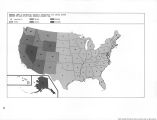| OCR Text |
Show sion on this matter because premises for the conclusion are not known. We cannot contemplate what farm program will be in effect even next year. Certainly, we cannot guess with any accuracy as to product needs in the future, especially when we consider regional as well as national needs. Reclamation Law We recognize that the Reclamation Law 9 is no longer necessary as an instrument for the development of irrigated public lands. However, although the Reclamation Law of 1902 was enacted as a public land law, today it has ramifications far beyond that narrow scope. Reclamation projects provide multiple benefits, including water power, recreation, flood control, and water for municipal and industrial purposes, as well as for irrigation. Accordingly, we make no broad recommendation concerning the type of reclamation law that should govern Federal development of irrigated lands in the future, and instead recommend that the National Water Commission address itself to this question. The Sale of Public Lands for Agriculture Recommendation 69: Public lands should be sold for agricultural purposes at market value in response to normal market demand. Unreserved public domain lands and lands in land utilization projects should be considered for disposal for intensive agricultural purposes. Although only relatively few acres of public lands have been transferred into private ownership in recent years under the agricultural land laws, attempts to obtain such lands were made for rather substantial areas. We believe that this demand for public lands has been engendered in large part by the fact that these lands are available at a very low price if other legal requirements can be met. In other words, the demand for public lands under the agricultural land laws in recent years has been stimulated by the artificially low price of these lands. We believe that this condition is inconsistent with good land use planning and development and that it should not be permitted to continue. We propose, therefore, that sales of public lands for agricultural purposes be treated much the same as sales of other lands or resources. Lands should be sold only when a market demand exists in the local area of the lands and the potential purchaser or purchasers are willing to pay the fair market value of the lands, as determined by local conditions. If regional demands for 9 n. 4, supra. TOTAL VALUE OF FARM CROPS HARVESTED IN THE 11 WESTERN STATES, 1967 STATE CALIFORNIA The value of farm crops contributes substantially to the income of western states. agricultural lands do not exist under these conditions, we believe it is in the best interests of the regional and local people and governments for the land to remain in public ownership. We note the extent to which agricultural land use patterns have changed over the years with changes in the use of machinery, fertilizers, and irrigation. It is clear that the process of making land available for agriculture must be dynamic to meet these changing conditions. If the market is to serve as a guide to the area of lands to be transferred out of public ownership, the process of land classification must be repeated from time to time to reflect changes in market conditions. Whether or not sufficient market demand exists to make it advisable to offer public lands for sale will be a matter of judgment and will vary from time to time and place to place. Market value of land was not a consideration in the disposal of public domain lands under the settlement laws, i.e., the homestead laws, the Desert Land Act, and the Indian homestead and allotment laws.10 However, the temporary 1964 Public Land Sale Act authorizes the Secretary of the Interior to dispose of lands that have been classified as chiefly valuable for agricultural purposes through competi- 10 The payment of a small fee is required when application for entry is made under the homestead laws, but no fee is required for Indian homestead applicants. The Desert Land Act requires only the payment of the nominal sum of $1.25 per acre and proof that at least $3.00 per acre has been expended on reclamation and development. Reclamation homesteaders do not pay for their land, but must pay the construction charges apportioned to the irrigable area of their entry up to the limit of their ability to pay. (For the Indian Homestead Act, see 43 U.S.C. § 189 (1964) and for the General Indian Allotment Act see 25 U.S.C. §§ 334-336 (1964)). 179 |







































































































































































































































































































































































